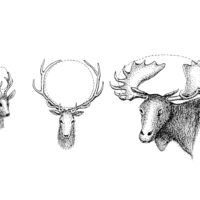Rudolf Steiner wrote in the last months of his life: «If we speak today in such a way that our thoughts can also be those of Christ, we oppose the Ahrimanic powers with something that protects us from falling for them. To understand the meaning of Michael’s mission in the cosmos is to be able to speak in this way. […] Not only through salvation from nature, not only through soul and divineness, should we learn the Christ language, but through the cosmos. Anthroposophy … wants to speak the Christ-Michael language.»1
Wolfgang Schad made a lifelong effort to read the book of nature, the book of the cosmos. He aimed to hear and think the Christ-Michael language by studying anthroposophy. He was too chaste to write it. But his effort was about penetrating the world accessible to the senses with ‹ideal knowledge›. The young Steiner wrote in his commentaries on Goethe’s scientific writings in chapter VI (Goethe’s mode of knowledge): «The awareness of the idea, in reality, is the true communion of humanity. […] This is idealism, […] which seeks the concrete ideological content of reality just as experientally as today’s hyper-exact research seeks factual content. […] We… take… a purified, higher empiricism as the basis.» Schad described this higher empiricism in his contribution to the book «Imagination. Das Erleben des schaffenden Geistes» [«Imagination. The Experience of the Creative Mind»2 in three stages, which he called: ‹imaginative›, ‹inspirational›, and ‹intuitive› ideal cognition.
‹Imaginative ideal cognition› begins with appropriating the colorful world of sensory impressions in an orderly way, so that imaginative images emerge that allow reality to become a personal treasure of experience. These experience-saturated ideas are the basis of all ideal knowledge of the world and succeed in capturing the sensory reality as thinking permeated by an idea. This is the ‹imaginative› stage of ideal knowledge, for which every act of cognition performed in nature is typology.
Typologizing is already a plastic process at this stage, in which ‹temporal› processes, form ‹transformation›, and metamorphoses are conceived, such as the evolution of vertebrates. The agility of ideal cognition, which takes place between the vividly dynamic capture of the researcher’s ideas and its examination of the sensory reality in the alternation of deduction and induction, becomes the ‹inspirational› element of cognition. Its spiritual content grows without losing the probing contact with reality and opens an encounter with a being through ‹intuitive› ideal cognition. For if in what has hitherto been called an idea, an active being can be thought, even experienced, then what Goethe said in his Plotinus Criticism applies: «However, a spiritual form is by no means shortened when it emerges in appearance, provided that its emergence is a true creation, a true reproduction. The begotten is no less than the creator. Indeed it is the advantage of living procreation that the begotten can be more excellent than the creator.»3
If organisms are grasped as developmental stages of spiritually working beings, then the ‹intuitive ideal cognition› prepares itself for the ‹encounter› with this essence, which still exists, even if it has physically gone through death. Anthropo‹sophy› describes the transition to this spiritual perception and then the perceptual contents themselves. It speaks the Christ-language when it depicts how the Son of God appeared to the senses and how this appearance itself, the corporeality of Jesus, developed through his life and death in such a way that it can serve as a ‹healing medicine› for evolving humanity, if it wants to make the Christ-impulse the basis of its behavior and action.

As early as 1967, with the comparison of beech-related trees (most comprehensively in the 2nd edition of his work «Säugetiere und Mensch» [«Humans and Mammals»] – and when he showed in his doctorate and dissertation with ‹inspirational› ideal knowledge developmental paths of vertebrate evolution, (which reveals how the spirit being human appears sensorily and can develop in the body that spirit consciousness enabling him to come in ‹intuitive› ideal cognition to the ‹encounter› with those spiritual beings who surround us), Schad conveyed on the ‹imaginative› level of cognition what leads to «Michaelic language about nature». It makes it possible to think about humans’ future development, and not just believe humans’ future development according to the account of the action of the Son of God as the Son of Man.
Schad led to Michaelic language – in imaginative, inspirational, and intuitive ideal cognition. He raised his speech by exaggerating his own speaking through Goethe’s poetry in reverence of Goethe. Goetheanism will be the «Christianity of the future.» «The Christ impulse already lives in him.» This is how he summarizes Steiner’s statements on Goetheanism.4
Translation Monika Werner
Footnotes
- From: «Menschheitszukunft und Michael-Tätigkeit» [«The future of Humanity and Michael’s Activities»], Guideline on the Guiding Principles 112-114 from Nov. 2, 1924, in: Rudolf Steiner, «Anthroposophische Leitsätze« [«Anthroposophical Principles»] (GA 26).
- Ed. by Roland Halfen and Andreas Neider, Stuttgart 2002, 31-65.
- Number 27 in «Makariens Archiv» [«Makarien’s Archive»] at the end of Goethe’s novel «Wilhelm Meisters Wanderjahre»[«Wilhelm Meister’s Journeyman Years»].
- S. Note 2 and GA 169/192; 185/201.













